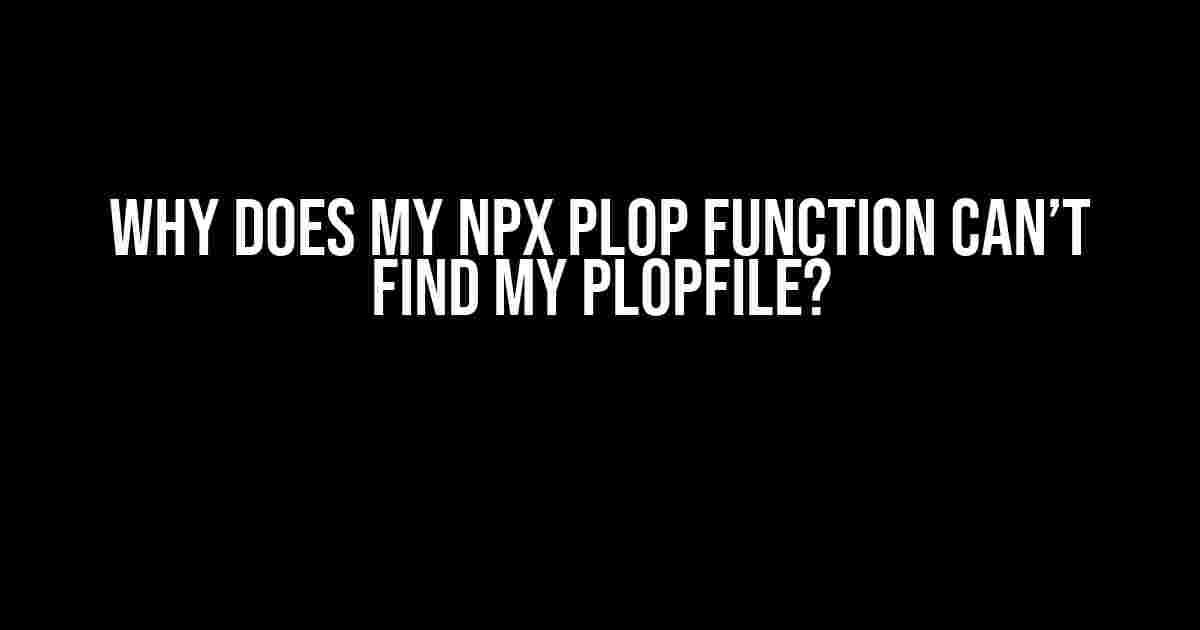Are you tired of struggling with your Plopfile and wondering why your npx plop function can’t find it? You’re not alone! In this article, we’ll dive into the most common reasons behind this frustrating issue and provide you with clear, step-by-step instructions to get your Plopfile back on track.
What is a Plopfile?
Before we dive into the solution, let’s quickly cover what a Plopfile is. A Plopfile is a configuration file used by Plop.js, a popular tool for generating boilerplate code. It’s essentially a JSON file that defines the templates, prompts, and behaviors for your generator. Plop.js reads this file to determine how to generate your code.
Why Can’t npx plop Find My Plopfile?
There are several reasons why your npx plop function might not be finding your Plopfile. Let’s explore the most common causes:
- Incorrect File Path: The most obvious reason is that the file path to your Plopfile is incorrect. Double-check that the path you’re providing is correct and that the file exists.
- File Name or Extension Issues: Make sure your Plopfile has the correct name and extension. The default name is “plopfile.js”, but you can customize it as long as it follows the correct naming convention.
- Plop.js Version Conflicts: If you’re using an outdated version of Plop.js, it might not be compatible with your Plopfile. Ensure you’re running the latest version of Plop.js.
- Mismatched Node.js Versions: Plop.js relies on Node.js to function. If you’re running a different version of Node.js than what Plop.js expects, it might cause issues. Check that your Node.js version is compatible with Plop.js.
- Corrupted or Malformed Plopfile: Sometimes, a corrupted or malformed Plopfile can prevent Plop.js from reading it. Try rewriting your Plopfile or checking for syntax errors.
Troubleshooting Steps
Now that we’ve covered the common causes, let’s walk through some troubleshooting steps to help you resolve the issue:
- Check the File Path: Verify that the file path to your Plopfile is correct. You can do this by running the command
npx plop --plopfile path/to/plopfile.js, replacing “path/to/plopfile.js” with the actual path to your Plopfile. - Verify File Name and Extension: Confirm that your Plopfile has the correct name and extension. If you’ve customized the name, ensure it follows the correct naming convention.
- Update Plop.js: Run the command
npx plop --versionto check the version of Plop.js you’re running. If you’re using an outdated version, update to the latest version usingnpx plop@latest. - Check Node.js Version: Run the command
node --versionto check the version of Node.js you’re running. Ensure it’s compatible with Plop.js. - Validate Plopfile Syntax: Use a JSON validator tool or a code editor with syntax highlighting to check for any syntax errors in your Plopfile. Fix any errors you find and try running the command again.
Additional Debugging Techniques
If the above steps don’t resolve the issue, try these additional debugging techniques:
- Enable Debugging Mode: Run the command
npx plop --debugto enable debugging mode. This will provide more detailed output that can help you identify the issue. - Check the Plop.js Logs: Run the command
npx plop --log-level debugto enable debug logging. This will generate a detailed log file that can help you diagnose the problem. - Use a Different Plopfile Name: Try renaming your Plopfile to a different name, such as “custom-plopfile.js”, to see if the issue is specific to the default name.
Common Scenarios and Solutions
Here are some common scenarios and their solutions:
| Scenario | Solution |
|---|---|
| I’m using a custom Plopfile name, but npx plop can’t find it. | Use the --plopfile flag to specify the custom file name, like this: npx plop --plopfile custom-plopfile.js. |
| I’m running npx plop from a different directory than where my Plopfile is located. | Use the --cwd flag to specify the working directory, like this: npx plop --cwd path/to/plopfile/directory. |
| I’m using a Plopfile with a non-standard extension (e.g., .json, .yaml). | Use the --plopfile-ext flag to specify the custom extension, like this: npx plop --plopfile-ext .json. |
Conclusion
Troubleshooting a missing Plopfile can be frustrating, but by following these steps and techniques, you should be able to resolve the issue. Remember to check the file path, verify the file name and extension, update Plop.js, and validate your Plopfile syntax. If you’re still stuck, try enabling debugging mode, checking the Plop.js logs, and experimenting with different Plopfile names.
Remember, a well-configured Plopfile is key to a smooth development experience. By following these guidelines, you'll be generating boilerplate code like a pro in no time!
Happy coding!
Frequently Asked Question
If you’re stuck wondering why your npx plop function can’t find your plopfile, don’t worry, you’re not alone!
Is my plopfile in the right location?
Double-check that your plopfile is in the root of your project directory, or specify the path to your plopfile using the `–plopfile` flag. For example: `npx plop –plopfile path/to/your/plopfile.js`.
Is my plopfile named correctly?
Make sure your plopfile is named exactly `plopfile.js` (or `plopfile.ts` if you’re using TypeScript). If you’ve named it something else, you’ll need to specify the filename using the `–plopfile` flag.
Am I running npx plop from the correct directory?
Ensure you’re running `npx plop` from the root of your project directory, where your plopfile is located. If you’re running it from a different directory, npx plop won’t be able to find your plopfile.
Is there a syntax error in my plopfile?
Check your plopfile for any syntax errors. A single mistake can prevent npx plop from loading your plopfile. Try running your plopfile through a linter or code editor to catch any errors.
Have I installed Plop.js correctly?
Verify that you’ve installed Plop.js correctly by running `npm install plop` or `yarn add plop`. If you’re still having trouble, try reinstalling Plop.js or checking the installation logs for errors.

